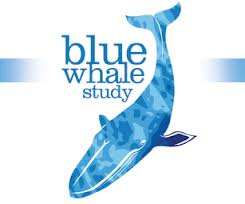|
Blue Whale Study aerial surveys, southern Australia 2002-2007
Blue Whale Study Inc.
Dataset credit
Blue Whale Study Inc.
|
Contacts
| Role | Name | Organization | |
|---|
| Primary contact |
Peter Gill |
Blue Whale Study Inc. |
 |
| Data entry |
Connie Kot |
|
 |
|
Citation
Gill, P. 2015. Blue Whale Study aerial surveys, southern Australia 2002-2007. Version 1.5.0. Dataset published in OBIS-SEAMAP. https://doi.org/10.82144/14f7458d. Halpin, P.N., A.J. Read, E. Fujioka, B.D. Best, B. Donnelly, L.J. Hazen, C. Kot, K. Urian, E. LaBrecque, A. Dimatteo, J. Cleary, C. Good, L.B. Crowder, and K.D. Hyrenbach. 2009. OBIS-SEAMAP: The world data center for marine mammal, sea bird, and sea turtle distributions. Oceanography. 22(2):104-115.
|
Abstract
Blue whales Balaenoptera musculus aggregate to feed in a regional upwelling system during November–May between the Great Australian Bight (GAB) and Bass Strait. We analyzed sightings from aerial surveys over 6 upwelling seasons (2001–02 to 2006–07) to assess within-season patterns of blue whale habitat selection, distribution, and relative abundance. Habitat variables were modelled using a general linear model (GLM) that ranked sea surface temperature (SST) and sea
surface chlorophyll (SSC) of equal importance, followed by depth, distance to shore, SSC gradient, distance to shelf break, and SST gradient. Further discrimination by hierarchical partitioning indicated that SST accounted for 84.4% of variation in blue whale presence explained by the model, and
that probability of sightings increased with increasing SST. The large study area was resolved into 3 zones showing diversity of habitat from the shallow narrow shelf and associated surface upwelling of the central zone, to the relatively deep upper slope waters, broad shelf and variable upwelling of
the western zone, and the intermediate features of the eastern zone. Density kernel estimation showed a trend in distribution from the west during November–December, spreading south-eastward along the shelf throughout the central and eastern zones during January–April, with the central zone most consistently utilized. Encounter rates in central and eastern zones peaked in February, coinciding with peak upwelling intensity and primary productivity. Blue whales avoided inshore upwelling centers, selecting SST ~1°C cooler than remotely sensed ambient SST. Whales selected
significantly higher SSC in the central and eastern zones than the western zone, where relative abundance was extremely variable. Most animals departed from the feeding ground by late April.
|
Purpose
A primary objective of the present study was to use modelling (i.e., general linear model [GLM]) to assess the relative importance of a range of biophysical habitat variables in explaining whale distribution (see
Redfern et al. 2006 for a review of cetacean habitat modelling). To do this we used blue whale sighting data from aerial surveys over 6 upwelling seasons, in combination with bathymetric, remote sensing, and temperature logger data. Another objective was to explain within-season patterns of distribution and
relative abundance of foraging blue whales in this upwelling system using density kernel estimation and monthly variabililty in encounter rates. Furthermore, the present study presented an opportunity to assess whether the Bonney Upwelling surface plume, representing a shoaling of the thermocline rarely observed in blue whale feeding grounds elsewhere, provided insights into relationships between whales and upwelling in this region.
Reference: Redfern, J.V., M.C. Ferguson, E.A. Becker, K.D. Hyrenbach et al. 2006. Techniques for cetacean-habitat modelling.
Marine Ecological Progress Series 310:271–295.
|
Supplemental information
N/A
|
Change History
The dataset has been updated over time as outlined below. Each entry includes the version number, release date, type of change, and a short description.
- 1.5.0 (2021-04-24) - Update - Published after organisation is set and ready to be registered into GBIF.
- 1.4.0 (2017-08-04) - Update - IPT server updated to v2.3.4.
- 1.2.0 (2016-09-01) - Update - Data and metadata update.
- 1.0.1 (2015-06-04) - Update - The identification of the species is updated from Balaenoptera musculus to Balaenoptera musculus brevicauda.
- 1.0.0 (2013-07-02) - Initial
|
References
|
Attributes
Overview
This section explains attributes included in the original dataset.
OBIS-SEAMAP restricts the attributes available to the public to date/time, lat/lon and species names/counts only.
Should you need other attributes described here, you are encouraged to contact the data provider.
Attributes described below represent those in the original dataset provided by the provider.
Only minimum required attributes are visible and downloadable online. Other attributes may be obtained upon provider's permission.
Attributes in dataset
| Attribute (table column) | Description |
|---|
| oid | Unique ID (created by OBIS-SEAMAP) |
| dattimeutc | Date/time UTC |
| obs_date | Date of observation |
| obs_time | Time of observation |
| longitude | Longitude of observation |
| latitude | Latitude of observation |
| obs_count | Number of animals |
| sp_obs | Species observed |
| sp_tsn | ITIS Taxonomic Serial Number added by OBIS-SEAMAP |
| geom | definition not provided |
| timezone | definition not provided |
|
|

| OBIS-SEAMAP ID | 971 |
| DOI | 10.82144/14f7458d |
| Version | 1.5.0 |
| Seabirds | 0 |
| Marine mammals | 408 |
| Sea turtles | 0 |
| Rays and sharks | 0 |
| Other species | 0 |
| Non spatial | 0 |
| Non species | 0 |
| Total | 408 |
| Date, Begin | 2002-01-19 |
| Date, End | 2007-05-16 |
| Temporal prec. | 111111 |
| Latitude | -39.38 - -35.05 |
| Longitude | 134.06 - 143.30 |
| Coord. prec. | 5 decimal digits |
| Platform | Plane |
| Data type | Animal sighting |
| Effort | N/A |
| Registered | 2013-07-02 |
| Updated | 2015-06-04 |
| Status | Published |
Sharing policy |
CC-BY-NC (Minimum) |
| Shared with |
GBIF
OBIS |
| Metadata in static HTML / FGDC / EML |
| See download history / statistics |
|

